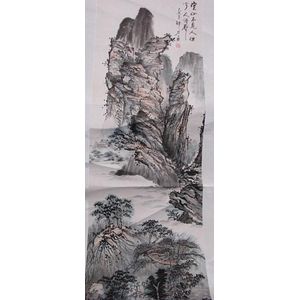Traditional Chinese Landscape Scroll
You must be a subscriber, and be logged in to view price and dealer details.
Subscribe Now to view actual auction price for this item
When you subscribe, you have the option of setting the currency in which to display prices to $Au, $US, $NZ or Stg.
- Grisaille - Decorative painting in monochrome, usually shades of grey, olive green or buff, painted on wood, plaster, ceramic or stone surfaces to imitate marble figural sculpture or relief ornament.Grisaille, from the French "gris", or grey (colour) is a painting technique in which a monochrome image is created using only shades of gray, black and white, usually created by using a gray underpainting or a limited colour palette. It is often used to create the illusion of sculpture or relief on a flat surface, and was commonly used during the Renaissance and Baroque periods.
The technique of grisaille has been used in decorative arts for centuries. It was commonly used in the Renaissance and Baroque periods in Europe to create the illusion of sculptural relief on flat surfaces such as walls, ceilings, and furniture. This technique allowed artists to create the illusion of depth and dimensionality without the use of colour.
During the Rococo period, grisaille was often used in the production of ceramics and porcelain to create finely detailed designs on a white or light-colored surface.
In the 19th century, grisaille continued to be used in decorative arts, particularly in the production of ceramics, both Western and Oriental.
This item has been included into following indexes:
Visually similar items

A Chinese hanging scroll of a scholar and a boy in a mountain landscape. Yang Jiayi, 19th-20th century, ink and colour on silk, inscribed, signed and one seal of the artist, 94.5 x 38.5 cm

A Chinese hanging scroll, Third quarter 20th century. On paper and laid upon paper backed cream textured fabric, depicting a figure in a pavilion within a traditional sublime landscape setting, in a predominantly grisaille palette with inflections of colou

A Chinese hanging scroll, in ink and muted colours on paper on self patterned silk and depicting a traditional dramatic rock, pinetree and bamboo landscape with a small pavilion, with script to the upper right of scroll and a banner of large and small; in

A Chinese scroll of a mountain scene with silk brocade. Length 221 cm. Width 60 cm
